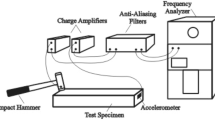Abstract
In ground modal testing, soft suspensions are usually employed to simulate the free-free boundary condition for flexible structures, the suspension system will introduce additional stiffness to structures, which causes the measured frequency response functions (FRFs) to deviate from the true value. To obtain the exact FRFs, a novel method is proposed to eliminate the additional effect of the boundary condition based on the Sherman-Morrison-Woodbury formula. Taking account of the position of suspensions and the number of response points, the effects can be eliminated by selecting sufficient measured FRFs. A spring-mass system is adopted to verify the method through simulated numerical experiments, and a flexible beam is employed to verify the additional stiffness elimination in ground modal testing. Results show that the natural frequency of the structure under test has different sensitivities with respect to the suspension effects, and the first-order mode is the most susceptible. When FRFs relevant to the suspension, excitation, and response points are measured, the additional effects of the boundary condition can be removed from measured FRFs.
Similar content being viewed by others
References
C. Hizal, FRF-based probabilistic modal parameter identification of structures with known seismic input, Mechanical Systems and Signal Processing, 189 (2023) https://doi.org/10.1016/j.ymssp.2022.110092.
R. Zhu, Q. G. Fei, D. Jiang and Z. F. Cao, Dynamic sensitivity analysis based on sherman-morrison-woodbury formula, AIAA Journal, 57 (2019) 4992–5001, https://doi.org/10.2514/1.J058280.
M. R. Ashory, High quality modal testing methods, Ph.D. Thesis, Imperial College of Science, Technology and Medicine, University of London (1999).
R. Zhu, Q. G. Fei and D. Jiang, Removing adverse effect of measurement process in flotation method, Proceedings of the Institution of Mechanical Engineers Part G-Journal of Aerospace Engineering, 236 (2022) 2842–2848, https://doi.org/10.1177/09544100211068218.
S. Bi, J. Ren, W. Wang and G. Zong, Elimination of transducer mass loading effects in shaker modal testing, Mechanical Systems and Signal Processing, 38 (2013) 265–275, https://doi.org/10.1016/j.ymssp.2013.02.010.
A. Panda and S. Modak, An FRF-based perturbation approach for stochastic updating of mass, stiffness and damping matrices, Mechanical Systems and Signal Processing, 166 (2022) https://doi.org/10.1016/j.ymssp.2021.108416.
J. Ren, J. Wang and S. Bi, Correction of transducers mass effects from the measured FRFs in hammer impact testing, Shock and Vibration, 4 (2017) 1–10, https://doi.org/10.1155/2017/6857326.
K. Zhou, Q.-S. Li and X. Li, Eliminating beating effects in damping estimation of high-rise buildings, Journal of Engineering Mechanics, 145 (2019) https://doi.org/10.1061/(ASCE)EM.1943-7889.0001681.
A. Yadav and N. K. Singh, Investigation for accelerometer mass effects on natural frequency of magnesium alloy simply supported beam, Proceedings of the 2nd International Conference on Advances in Mechanical Engineering and Nanotechnology (ICAMEN), Jaipur, India (2020) 2561–2565, https://doi.org/10.1016/j.matpr.2020.05.279.
R. Zhu, Q. Fei, D. Jiang and Z. Cao, Removing mass loading effects of multi-transducers using sherman-morrison-woodbury formula in modal test, Aerospace Science and Technology, 93 (2019) https://doi.org/10.1016/j.ast.2019.06.022.
R. Brillhart and D. Hunt, Lessons learned modal testing part 1: the pitfalls, pratfalls, and downfalls of fixturing, Experimental Techniques, 29 (2005) 58–61, https://doi.org/10.1111/j.1747-1567.2005.tb00250.x.
T. Carne, D. Griffith and M. Casias, Support conditions for free boundary-condition modal testing, Sound and Vibration (2006).
K. McConnell and P. Varoto, Vibration Testing: Theory and Practice, 2nd Ed., John Wiley & Sons. Inc., USA (2009).
A. Munsi, A. J. Waddell and C. A. Walker, Modal analysis of a lightweight structure - Investigation of the effects of the supports on the structural dynamics, Mechanical Systems and Signal Processing, 16 (2002) 273–284, https://doi.org/10.1006/mssp.2000.1393.
V. Cooley and A. Giunta, Laboratory evaluation of two advanced suspension devices for ground vibration testing of large space structures, 33rd Structures, Structural Dynamics and Materials Conference, Dallas, USA (1992) https://doi.org/10.2514/6.1992-2334.
L. Yang, M. Chew and J. Juang, Band-drive suspension mechanism design for ground-based testing of flexible space structures, Journal of Mechanical Design, 117 (1995) 134–142, https://doi.org/10.1115/L2826098.
G. Greschik and W. Belvin, High-fidelity gravity offloading system for free free vibration testing, Journal of Spacecraft and Rockets - J Spacecraft Rocket, 44 (2007) 132–142, https://doi.org/10.2514/1.21454.
C. Chang and D. Hodges, Parametric studies on ground vibration test modeling for highly flexible aircraft, Journal of Aircraft - J AIRCRAFT, 44 (2007) 2049–2059, https://doi.org/10.2514/1.30733.
G. Lopp, B. Pacini and R. Mayes, A method for canceling force transducer mass and inertia effects, 33rd Structures, Structural Dynamics and Materials Conference, Dallas, USA (2018) 49–60, https://doi.org/10.1007/978-3-319-75390-4_4.
O. Cakar and K. Sanliturk, Elimination of transducer mass loading effects from frequency response functions, Mechanical Systems and Signal Processing - Mech Syst Signal Process, 19 (2005) 87–104, https://doi.org/10.1016/S0888-3270(03)00086-4.
C. Pan and Z. Chen, Elimination of accelerometer mass loading effects in sparse identification of impact forces, Mechanical Systems and Signal Processing, 191 (2023) 110178, https://doi.org/10.1016/j.ymssp.2023.110178.
F. Zhao, W. Du and H. Li, Eliminating the influence of additional sensor mass on structural natural frequency in the modal experiment, Vibration Engineering for a Sustainable Future (2021) 73–79, https://doi.org/10.1007/978-3-030-48153-7_10.
M. Batista, A note on a generalization of Sherman-Morrison-Woodbury formula, arXiv:0807.3860 (2008) https://doi.org/10.48550/arXiv.0807.3860.
Q. Song, L. Zhanqiang, Y. Wan, G. Ju and J. Shi, Application of Sherman-Morrison-Woodbury formulas in instantaneous dynamic of peripheral milling for thin-walled component, International Journal of Mechanical Sciences, 96–97 (2015) 79–90, https://doi.org/10.1016/j.ijmecsci.2015.03.021.
S. Chang and M. Cho, Dynamic-condensation-based re-analysis by using the sherman-morrison-woodbury formula, AIAA Journal, 59 (2021) 1–7, https://doi.org/10.2514/LJ059738.
Acknowledgments
This work is supported by the National Natural Science Foundation of China (11602112, 52202445), the Natural Science Foundation of the Jiangsu Higher Education Institutions of China (20KJB460003), Qinglan Project of Jiangsu Province of China (2020).
Author information
Authors and Affiliations
Corresponding author
Additional information
Dong Jiang is an Associate Professor at the College of Mechanical and Electronic Engineering, Nanjing Forestry University. He received his Ph.D. in Mechanics from Southeast University. His research interests including structural dynamics and nonlinear vibration.
Rights and permissions
About this article
Cite this article
Jiang, D., Huang, Z., Wang, G. et al. Reducing effects of boundary condition in modal testing of flexible structures. J Mech Sci Technol 38, 89–99 (2024). https://doi.org/10.1007/s12206-023-1208-9
Received:
Revised:
Accepted:
Published:
Issue Date:
DOI: https://doi.org/10.1007/s12206-023-1208-9




